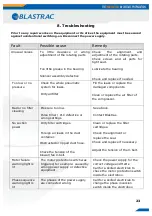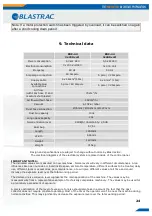
9
3.7
Transport safety
a)
Be aware of your surroundings and machine operating level. Do not side hill, do not run on steep incline,
this could cause machine to tip over.
b)
Remove the dust from the dust collector before the dust collector is transported.
c)
Always dispose the contents of the dust collector before the end of the working day. Observe the local
waste disposal regulations!
d)
Before the dust collector is removed from the hazardous zone, take precautions to prevent dust from
escaping.
e)
For class H and M machines, the outside of the machine should be decontaminated by cleaning and
vacuuming methods, de-dusted before being taken out from the hazardous zone. All parts of the dust
collector must be considered as contaminated when they are removed from the hazardous zone and
appropriate actions must be taken to prevent dust from dispersing.
f)
Always close the inlet of the dust collector with the appropriate plug when the dust hose is disconnected.
g)
Make sure the dust hoses are disconnected and put away properly before transport.
h)
The net weight of the BDC-44 is 315 kg. Use a crane or lift when transporting the machine, use the lifting
eye of the machine.
i)
Before every use check the lifting eye and welds for:
deformation, damages, cracks, corrosion and wear.
j)
Only lift the machine on the lifting eyes.
k)
When lifting the machine from the ground, always use the lowest lifting speed. The cables must first be
tensioned at this speed; they must not be slack when the machine is lifted from the ground.
l)
During hoisting make sure to be at a safe distance from the machine with the most optimal view on the
machine and working environment.
m)
Never stand directly below the machine.
n)
Never use the machine for lifting persons or items.
o)
When transporting the machine do so in such a manner that damage due to the effects of the use of force
or incorrect loading and unloading is avoided.
p)
The lifting eye can also be used to fasten the machine on a pallet or during transport.
q)
Always drive backwards when driving up to a ramp or grade, and forwards when driving of the ramp.
r)
Chock wheels for transport, use the brakes on the wheels.
s)
Don’t leave the machine unsecured on jobsites.
t)
Park the machine always on a flat horizontal and levelled surface.
u)
Make sure the electrical cable and dust hose are disconnected before transport.
v)
Store the cleaned and dry machine in a humid free room. Protect the electrical motor from moisture, heat
dust and shocks.
w)
Use the lifting points on top of the machine when lifting the machine by crane.
Lifting points




































